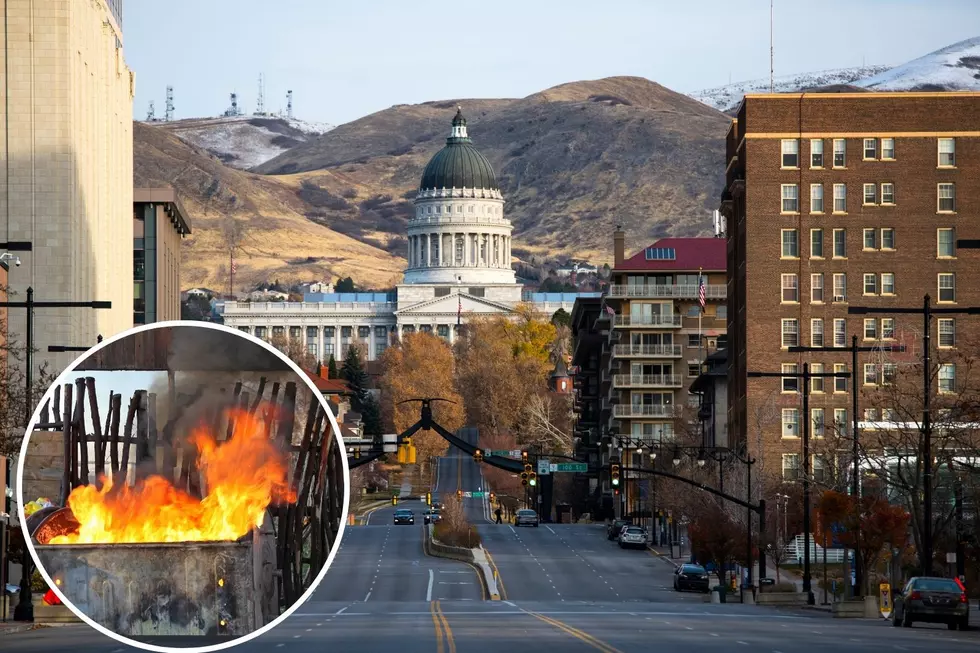
Decoding St. Patrick’s Day: Origins, Myths, And Modern Traditions
Legend has it that mischievous leprechauns are color blind to the shades of green and that's why we're supposed to wear the color on St. Patrick's Day.
So the little buggers can't pinch you.
And while that silly myth has persisted throughout the ages, the actual St. Patrick myths are starting to melt away.
Sunday is St. Patrick's Day. Named for the patron saint of Ireland, March 17th is the day St. Patrick is believed to have died around 490 A.D.
There are many legends about him including that he drove the snakes out of Ireland and used the shamrock to explain the Trinity.
Ireland came to celebrate his day with religious services and feasts.
American cities with large numbers of Irish immigrants staged the most extensive celebrations and elaborate parades.
Boston held its first St. Patrick's Day parade in 1737, followed by New York City in 1762.
Many cities across the U.S. joined and added traditions of their own including Chicago, which has been dying its river green since 1962 to mark the holiday.
But a lot of the stories about the patron saint are either false or exaggerated. From History.com:
- St. Patrick was Irish -- Though one of Ireland’s patron saints, Patrick was born in what is now England, Scotland or Wales—interpretations vary widely—to a Christian deacon and his wife, probably around the year 390. According to the traditional narrative, at 16 he was enslaved by Irish raiders who attacked his home; they transported him to Ireland and held him captive there for six years. Patrick later fled to England, where he received religious instruction before returning to Ireland to serve as a missionary.
- St. Patrick was British -- His birthplace doesn’t mean Patrick was a Brit, however—at least not technically. During his lifetime the British Isles were occupied by the Romans, a group that included Patrick’s parents and thus the saint himself. It is unknown whether his family—thought to have been part of the Roman aristocracy—was of indigenous Celtic descent or hailed from modern-day Italy. When Patrick penned the two surviving documents attributed to him, he wrote in Latin and signed his name “Patricius,” but according to some accounts he was born Maewyn Succat.
- St. Patrick brought Christianity to Ireland -- In 431, before Patrick began preaching in Ireland, Pope Celestine reportedly sent a bishop known as Palladius “to the Irish believing in Christ”—an indication that some residents of the Emerald Isle had already converted by then. One theory holds that the St. Patrick of lore is actually an amalgam of two men: Palladius and the deacon’s son who first visited Ireland as an enslaved man.
- St. Patrick banished snakes from the Emerald Isle -- Legend has it that Patrick stood on an Irish hillside and delivered a sermon that drove the island’s serpents into the sea. While it’s true that the Emerald Isle is mercifully snake-free, chances are that’s been the case throughout human history. Water has surrounded Ireland since the end of the last glacial period, preventing snakes from slithering over; before that, it was blanketed in ice and too chilly for the cold-blooded creatures. Scholars believe the snake story is an allegory for St. Patrick’s eradication of pagan ideology.
- Green has historically been associated with St. Patrick’s Day -- The Irish countryside may be many shades of green, but knights in the Order of St. Patrick wore a color known as St. Patrick’s blue. Why did green become so emblematic of St. Patrick that people began drinking green beer, wearing green and, of course, dyeing the Chicago River green to mark the holiday he inspired? The association probably dates back to the 18th century, when supporters of Irish independence used the color to represent their cause.
- Popular St. Patrick’s Day festivities have their roots in Ireland -- Until the 1700s, St. Patrick’s Day was a Roman Catholic feast only observed in Ireland—and without the raucous revelry of today’s celebrations. Instead, the faithful spent the relatively somber occasion in quiet prayer at church or at home. That started to change when Irish immigrants living in the United States began organizing parades and other events on March 17 as a show of pride. For many people around the world, St. Patrick’s Day has evolved into a secular ode to Irish culture (or at least an oversimplified version of it), characterized by parties, music and iconic foods.
- Corned beef is a classic St. Patrick’s Day dish -- On St. Patrick’s Day, countless merrymakers in the United States, Canada and elsewhere savor copious plates of corned beef and cabbage. In Ireland, however, a type of bacon similar to ham is the customary protein on the holiday table. In the late 19th century, Irish immigrants in New York City’s Lower East Side supposedly substituted corned beef, which they bought from their Jewish neighbors, in order to save money. That’s not to say salt-cured beef isn’t a traditional Irish dish; pork, however, has historically been more widely available on the Emerald Isle.

A Utah Murder Story Too Unbelievable To Be True (But It Is)
There's a murder story from Northwestern Utah that is so bizarre, so unlikely that it can't possibly be true.
But it is.
First of all, the facts:
- On Feb. 16, a 9-year-old Tooele boy admits he shot and killed his father with a 9MM handgun. It happened at around 7 p.m. The gunshot wound was in the back of the head.
- The deceased 32-year-old victim also had dozens of hatchet wounds on his body. Authorities aren't sure, but they think the wounds were suffered after the victim had been shot, but before he passed away.
- A bloody "tomahawk-style" hatchet was found under the bed of the deceased, a bed he shared with the admitted killer.
- Seven other people (mostly children) were home at the time of the attack. None of them heard anything, including the gunshots. They were only made aware of the crime when the boy exited the room and stated that his dad was bleeding from the head and was dead (he actually died later that night at the hospital)..
- The victim and accused killer, according to the warrant, “retired to bed early due to behavioral problems and went into the bedroom that they share."
- Medical officials said the hatchet wounds on the victim appeared to be defensive wounds, meaning the victim appeared to be trying to defend himself during the attack.
- The 9-year-old accused killer was reportedly extremely into video games, especially a newer version of a war game called 'Modern Warfare: Warzone'
- In that game, two of the commonly used weapons are 9MM handguns and tomahawk strikes.
There are so many questions that need to be answered (Where was the mom? Where'd he get the gun? How did the child learn this behavior? Was the act in retaliation for some "disciplinary measures? Why didn't anyone in the house hear anything?).
But the most pressing question of all is this: Are our kids getting so desensitized to violence because of video games that the lines between right and wrong are blurred, even gone?
When my kids were younger I had just one rule when they played games: No killing humans -- if you're killing something, it had better be a monster or an alien.
Maybe it was a stupid rule, I don't know. Or maybe it saved my life.

UDOT Grant Boosts St. George Connectivity With New Street Crossings
The U.S. Department of Transportation has announced a grant award of $87,618,600 to the Utah Department of Transportation (UDOT) toward funding local street crossings of Interstate 15 in St. George at 400 East and 900 South.
St. George City is one of 132 communities nationwide to benefit from the federal Reconnecting Communities & Neighborhoods Grant Program. The new crossings will provide additional connectivity of local routes on the east and west side of St. George at I-15.
“We are so thrilled to obtain funding ... to create two much-needed underpasses in St. George," said St. George Mayor Michele Randall. "One of our biggest challenges is transportation. We live in a city with ridges to the north, west and east, two rivers and an interstate cutting through the middle of town.
"These underpasses will mean less time on the roads getting from Point A to Point B and help alleviate some of our traffic congestion.”
The timing of the announcement comes at an opportune time for UDOT as it begins final design of additional lanes on I-15 between Exits 6 and 8, under which the crossings would be located.
UDOT credits community involvement from the residents and City of St. George along with the Dixie Metropolitan Planning Organization in working toward a unified vision with UDOT.
Other ways this benefits St. George
- Provides increased connectivity through and around I-15 by connecting 400 E (Flood Street) and 900 South underneath I-15 via underpasses
- The underpasses will accommodate both motor vehicles and active transportation
- Requires raising the elevation of I-15 to accommodate underpass structures
- This project is to coincide with the I-15: Widening from Exit 6 to Exit 8 Project already planned by UDOT
- The proposed design includes dedicated active transportation infrastructure, which will help decrease transportation-sector greenhouse gas emissions by improving multimodal access, mobility and safety. These improved connections will also help reduce vehicle miles traveled by providing a local option for shorter neighborhood trips.

Airbnb And Vrbo Face Crisis: The Future Of Short-Term Rentals
Airbnb and Vrbo might just be in trouble.
Financial trouble.
The two businesses that have made a killing (each worth more than $4-billion) off of people willing to rent out their houses or spare bedrooms around the world.
But the two businesses lacked oversight for a long time and truthfully had little in the way of ability to punish those that did break their lax rules.
In a recent policy change, Airbnb announced it is set to ban its hosts from having indoor security cameras in their properties beginning next month.
Uh, talk about too little, too late.
This morning on her daily vignette on KDXU (airs at about 6:55 a.m.), consumer tech expert Kim Komando said this:
"Airbnb and Vrbo are done, and they have only themselves to blame," she said. "Americans are fed up. We're done with all the creepy hosts, hidden spy cams, bad wi-fi and inaccurate descriptions. Hotels are back -- big time."
If you've ever stayed in a "house-sharing" situation, you know that at best, it's a little uncomfortable. At worst, it's scary, dangerous, creepy and dirty.
Komando said a lot of rental owners will likely be bailing out of the short-term rental business as the market begins to collapse. She issued this dire warning and a little advice this morning to those who own property they plan on using for short-term rental.
"A lot of these home-owners thought the short-term market would go on forever without giving any thought as to what was really happening in the marketplace.
"Look for many of rental properties to hit the market. You just might score a deal."

The Case Of The Mysterious Blast In Utah: A Closer Look
So often we hear in the news something like: "We'll bring you more information on the story as it develops," or "as it becomes available."
But the truth in the news media is most times the reporter has no intention of following up. Or if they do, they know that the follow-up news will be largely ignored.
Follow-ups are just not popular. We want the breaking news, not the "rest of the story."
But sometimes there is no more.
For instance, last year I reported on a story out of Northern Utah in which there was a loud explosion in the middle of the night.
Salt Lake County law enforcement investigated an explosion that happened in the Bluffdale area last March.
A loud boom was heard at about 1 a.m. on March 19 by residents from Lehi to West Valley City. Officials believe the explosion occurred "near the Point of the Mountain.".
Members of the Salt Lake County bomb squad and Draper police officers were flown to a remote area Saturday morning after a hiker found possible evidence of the blast, including a crater and what appeared to be shrapnel.
Ring cameras from several homes in the area confirmed that there was indeed a blast, but officers have not yet confirmed whether or not there was a "blast crater" as reported by the hiker.
Draper City officials and other large businesses in the area deny any knowledge of the mysterious blast, with Rocky Mountain Power and Geneva Rock claiming no involvement in the incident.
Authorities for Draper City said they would release more information about the explosion as it came available, but no information was ever released.
Social media users from Reddit to X and Facebook had many theories -- a meteor, a rocket, an explosion from Geneva Rock (they denied being involved) -- but all the theories were just speculation.
The truth is elusive in this case: an explosion happened, no one was hurt, several ring cameras recorded the incident from afar, a crater was found (but no meteor), and no one is claiming any involvement.
One commenter said it was simple "Aliens!"
We may never know. In this case, there is no follow-up.

Southern California To Las Vegas Bullet Train: The Future Of Travel
Have you ever driven from Southern Utah to Southern California?
The trip through the Virgin River Gorge and on through Mesquite into Las Vegas isn't bad most of the time. But that leg from Vegas to Los Angeles or San Diego is brutal.
No, it's worse than that. It flat out sucks.
Fifteen-mile traffic jams, freeway standstills, pollution, heat and a crawling pace make it miserable, especially on weekends and holidays.
But in a story that seemingly has flown mostly under the radar, a group called Brightline West thinks they have an answer to all that -- a bullet train connecting Southern California to Las Vegas.
From the newswire:
"The company Brightline West is planning to spend more than $10-billion laying the tracks down. It wants three-point-seven-five-billion dollars in federal funding. All six of Nevada's elected federal lawmakers and four House members from California tell U.S. Transportation Secretary Pete Buttigieg they support the proposal."
Vegas is all-in as the train would be a huge boon to tourism, basically giving access to millions of Southern Californians the playground that is Las Vegas.
The fact that there is another high-speed train already in place in the United States -- the East coast of Florida has a high-speed train between Miami and West Palm Beach -- makes this one more plausible.
Construction is already underway through the Mojave Desert. The train is expected to make stops in Hesperia and Rancho Cucamonga, terminating eventually in the Los Angeles area.
The train would top out at around 200-miles per hour and would cut the time it takes to travel the roughly 270-mile trip in half.
Nevada Senator Jacky Rosen told the Associated Press, “This project is a major priority because it will make southern Nevada more accessible to millions of visitors each year," she said, adding that it “will boost our economy and create more good-paying jobs.”
The project has passed several hurdles, including making it through the incredibly difficult Environmental Impact phase. Money now becomes the biggest obstacle.
A draft environmental assessment of the project was made public last October and the Federal Railroad Administration is expected to finalize permits in July. The company said about 70 percent of funding will be private, using a combination of debt and equity.
Amtrak previously had a passenger line through the desert, but that service ended nearly 30 years ago.
Brightline West trains would connect Las Vegas, Victorville, California, and Rancho Cucamonga — a city in San Bernardino County -- with a passenger station on a suburban Los Angeles light rail line.
So when will it become a reality?
According to the Las Vegas Review-Journal, "Brightline executives are hoping to open the western route, with speeds up to 200 mph, by 2028, in time for the Los Angeles Olympics. They plan to break ground in the spring if they complete financing."
Brightline estimates that 50 million people per year travel between Southern California and Las Vegas, more than 40 million of them in cars.
“They’ll have to drive past our train station and then watch the trains whiz by them at 220 mph” while they’re stuck in traffic, Brightline CEO Wes Edens told the Review-Journal. “It’ll be phenomenal.”
The train tracks will be built mostly in the I-15 freeway median.
LOOK: See how much gasoline cost the year you started driving
Gallery Credit: Sophia Crisafulli




